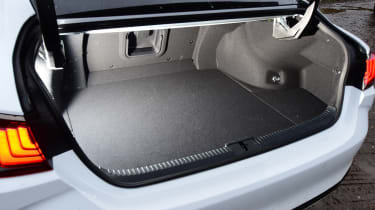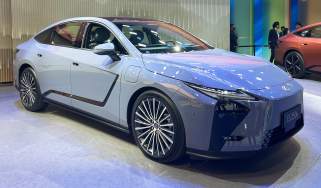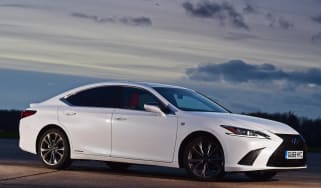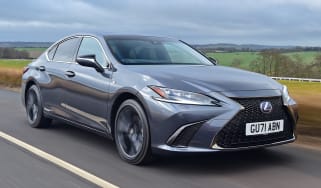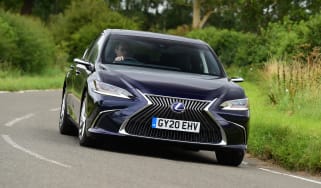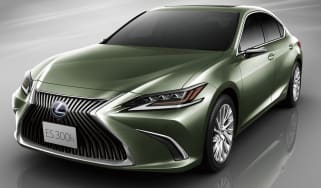Lexus ES review
The Lexus ES is a very comfortable and refined executive saloon with impressively low running costs

The Lexus ES has to compete with multiple executive car alternatives that focus on a sporty driving experience. If solely judged on this criterion, the Japanese saloon is sorely out-performed. That said, executive cars are assessed on a number of other key areas, such as refinement, comfort and interior quality. It is these areas where the ES claws back ground.
Furthermore, the ES comes with a very efficient hybrid powertrain, which, when combined with the above should appeal to those looking for an under-the-radar luxury saloon. Alongside low emissions and strong fuel economy, the ES promises relatively modest running costs – the latter being a boon for both business and private owners.
About the Lexus ES
In the UK market, ES is a relatively new name. In some countries, though, an executive saloon has been sold with the same moniker ever since Lexus started selling cars in 1989. In fact, when looking at worldwide sales, the ES is Lexus’ best selling model. Focusing back on the UK, Lexus replaced its GS with the ES in 2019. The biggest difference between the two being a switch from rear-wheel-drive to front-wheel-drive.
Being a large executive saloon, the ES’ key rivals are the BMW 5 Series, Mercedes E-Class and Audi A6. Other alternatives worth considering are the Volvo S90 and Jaguar XF. The Lexus ES takes a markedly different approach to all of these rivals, especially in the range of bodystyles and powertrains available.
Used - available now
Frustratingly (for some), the ES is only available as a saloon. This is in contrast to the BMW, Audi, Jaguar, Volvo and Mercedes which are all available as estates – some even have coupe derivatives as well.
As with the rest of the Japanese company’s range of vehicles, the ES comes as a petrol-electric hybrid. Although, unlike some of its siblings there is only one powertrain available - the 300h. It features a 2.5-litre four-cylinder naturally aspirated petrol engine with hybrid assistance, for a total of 215bhp.
The ES also only comes with front-wheel drive, whereas its main competitors all offer four-wheel drive – at least as an option. And the petrol-electric hybrid system can only be paired with a CVT transmission so no manual gearbox and definitely no high-performance version.
Lexus offers ES 300hs in standard, Premium Edition, F Sport and Takumi trim. The standard 300h version is well equipped and includes features usually listed as cost options such as adaptive cruise control with level 2 autonomy. Next up in the range is Premium Edition, which comes with 18-inch alloy wheels, a heated steering wheel, heated windscreen and wireless smartphone charging. Moving further up the model hierarchy, there is F Sport trim. This spec adds adaptive suspension and “triple eye” headlights – the former changing the character of the ES to a significant degree.
The top specification model is the Takumi, which adds luxury features like reclining heated rear seats, a premium Mark Levinson audio system and a head-up display. There are also a couple of option packs that can be bundled together with ES and F Sport models.
Engines, performance and drive
As with much of the Lexus range, the ES puts comfort ahead of other considerations, and it’s this aspect that dominates the driving experience. Everyone inside will enjoy the smooth ride that deals well with a variety of surfaces and remains composed on motorways or in town. This is helped by the excellent refinement of the powertrain, with the petrol engine and electric motor combining well to provide quiet, fuss-free motoring. This is particularly apparent when driving in traffic, where the car’s ability to operate on electric power only emphasises the sense of quiet within the cabin.
On more challenging roads, the ES retains its composure, and when driven at high speed the steering responds well, with good feedback and accurate responses to the driver’s inputs. The Lexus ES also features a new type of suspension damper called a Swing Valve Shock Absorber, the idea being that a valve inside the system helps it to respond better to bumps in the road and cornering loads. The result is that the ES corners relatively flat for a car of this size and is largely untroubled by road imperfections. What the Lexus ES lacks is the sharpness offered by rivals such as the BMW 5 Series and is more biased towards comfort than the Mercedes E-Class, which manages to be relaxing and enjoyable to drive, too.
Go for an F Sport model, and the standard adaptive suspension is firmer than in the lesser-equipped versions. Combine this with the 18-inch wheels, and the ES’s focus on comfort is lost somewhat.
The powertrain of the ES is also not best suited to enthusiastic driving. When driven in normal conditions it operates very well, with the engine and electric motor combining with the CVT automatic transmission to keep the engine dormant or at low revs as much as possible. Demand brisk acceleration, however, and the ES struggles, with the engine revving hard but delivering less performance than diesel rivals.
Engines, 0-60 acceleration and top speed
The ES is available with a single powertrain, a 2.5-litre four-cylinder petrol engine matched with an electric motor and battery pack, to give a total output of 215bhp. As mentioned there’s a single gearbox option, too, a CVT automatic transmission. The ES accelerates from 0-62mph in 8.9 seconds, as much as a second slower than comparable rivals from BMW and Mercedes, while its top speed is also a modest 112mph.
When driven at normal speeds the powertrain delivers smooth and quiet operation, with the gearbox operating with impressive efficiency. However, when strong acceleration is demanded, the four-cylinder unit shows some harshness as it sits at high revs, with only modest acceleration delivered. The CVT is an improvement on past Lexus models, though, so will be pleasing to use for existing Lexus owners.
MPG, CO2 and running costs
Depending on the trim and which alloy wheels are fitted, the ES is capable of between 50.4mpg and 54.3mpg under WLTP testing protocols, giving it a theoretical range of almost 600 miles on a single tank of fuel. Emissions are rated at 119g/km to 128g/km, again under WLTP standards – which means Benefit-in-Kind rates are between 26 and 28 per cent for company car drivers.
That makes it an appealing prospect, as it manages to compete with diesel rivals, but using petrol power. Similarly, compared to non-RDE2 compliant diesels (which face an additional company car Benefit-in-Kind levy of 4 per cent) the Lexus certainly has an allure for business drivers.
Road tax rates for the ES are competitive, although the price tag can affect this significantly. All models cost £175 in tax for year one and £150 thereafter. ES’ which cost more than £40,000 new (which includes F Sport versions with a Takumi Pack and Takumi models) are levied at an additional £325 per year for five years starting from the second time they are taxed. Importantly, more affordable models can be pushed over the £40,000 mark if enough optional equipment is added.
Electric range, battery life and charge time
Lexus doesn’t quote an official range for the ES when operating on electric power alone, because the system is set up to use the best combination of electric and petrol power for the driving conditions. Also, the battery pack is much smaller than most plug-in hybrids so its range would seem rather small.
Despite this, when driving around town the ES has the potential to travel on battery power most of the time, with the petrol engine only engaging when faster acceleration is needed. Like other Lexus hybrids, you can change the vehicle mode to save the battery for later in your journey and keep it fully charged. As the ES is what Lexus terms a ‘self-charging’ hybrid, power is returned to the battery by a combination of regeneration and engine power, so there is no need to plug it in.
Insurance groups
Insurance groups for the Lexus ES vary from 33 to 38 depending on specification. This range is broadly in line with rivals, although the lack of performance version means the highest group model is lower than equivalents from Audi and BMW.
Depreciation
The previous Lexus GS model retained between 37% and 44% of its value after three years, but the ES is expected to be slightly better, with a retained value of 41-46%. In comparison, the BMW 5 Series, Mercedes E-Class and Audi A6 are a couple of percentage points ahead of the ES – demonstrating that the German marques are still the popular ones in the sector.
To get an accurate valuation on a specific model check out our free car valuation tool
Interior, design and technology
The exterior design of the ES is instantly recognisable as a Lexus, combining the distinctive grille shape and slim headlights with a curved rear roofline, giving a coupe-like feel. Despite the strong nose treatment, the ES is relatively conservative in its design and is unlikely to put off many buyers as a result - in particular, the strong metallic red paint option brings out the best of the shape.
Although a brand-new design, the layout of the ES follows the template set by the LS and previous GS models, with an unfussy design, a slim grouping of buttons on the dashboard with a large transmission tunnel housing the main controls for the infotainment system. The quality of the materials is impressive, if not quite as good as the best in the class, but the result is a cabin that is comfortable and soothing, and feels built to cope with many thousands of miles.
Standard equipment is generous across the range, and even the entry-level model comes with heated electric front seats and adaptive cruise control with level 2 autonomy – usually a cost option in this segment. The top-spec Takumi model brings a larger infotainment screen, a Mark Levinson audio system and a head-up display.
Sat-nav, stereo and infotainment
The Lexus ES now comes with Android Auto and Apple CarPlay, plus wireless phone charging as standard with the Tech & Safety Pack, which is great to see – because it means you can bypass the built-in infotainment system, which we find poor.
The Lexus’ touchpad is fiddly to use, working like a very slow laptop trackpad, occasionally snapping to certain on-screen icons with little consistency. It’s hard to use, makes an annoying noise every time you move the cursor, the menus seem poorly thought out and the graphics are dated. You can adjust its settings, but it’s still not that user-friendly. Although we like the simple dials and the integration of the screen into the dashboard, the interface is a real letdown.
Practicality, comfort and boot space
The Lexus ES bucks the trend set by its main rivals by being available in saloon-form only, something that may make it unsuitable for some buyers. However, space inside the cabin is generous for occupants both front and rear. An electrically adjustable steering column and seats on all models make it easy for the driver to find a suitable seating position, and the rear seat can accommodate a smaller adult or child in the central rear seat.
Visibility is good forwards and to the sides, but rear visibility is slightly compromised by the sloping roofline which results in a narrow rear window. This is mitigated somewhat by the standard safety equipment, though, which includes a reversing camera as standard.
Size
At 4,975mm, the Lexus ES is one of the longest cars in the executive saloon car class, 36mm longer than the Audi A6. It also has the lowest roof height in the sector, but crucially it has the shortest wheelbase, which translates to a smaller cabin overall. In terms of width, the ES sits somewhere in the middle of the class at 1,865mm. That’s narrower than the Audi A6 and BMW 5-Series, but wider than a Mercedes E-Class.
Leg room, head room & passenger space
Although cabin space is smaller overall than in its key rivals, the room on offer for its occupants is generally impressive. Legroom is good for both front and rear passengers, and while headroom for front seat occupants is good, in the rear the sloping roofline impacts on the space available to the point where taller passengers may find it uncomfortable. Isofix points are fitted to the two outer seats in the rear.
Boot
The Lexus ES has the smallest boot amongst its key rivals, measuring 454 litres. That’s 76 litres down on the Audi A6 and BMW 5 Series and 96 litres less than a Mercedes E-Class. The boot space itself is accessed through a relatively narrow opening with a significant lip at its base, while the rear seat backs are fixed in place, so longer loads can’t be threaded through into the cabin.
Reliability and safety
While Lexus doesn’t promote the safety of its products as heavily as some manufacturers, the reality is that the ES has performed well under official testing and comes with a broad range of safety equipment both as standard and optionally.
The ES received a full five-star rating when it was tested by Euro NCAP in 2018, scoring 91% for adult occupant protection, 90% for vulnerable road user protection and 77% for its safety assist systems. As standard, all ES models come with the Lexus Safety System+ package, which includes autonomous emergency braking with pedestrian and cyclist detection, while there is also radar-guided cruise control and lane assist that provides Level 2 automated driver support. The Takumi model also adds a blind-spot monitor and rear cross-traffic alert as standard.
The ES didn't appear in our 2021 Driver Power owner satisfaction survey, but the Lexus brand as a whole has consistently been a strong performer over the years. It the best brand in the 2020 survey, although slipped to tenth place in 2021.
Warranty
The Lexus ES warranty covers a period of three years or 60,000 miles, which is broadly in line with its competitors in terms of the time period. However, some rivals offer unlimited mileage over the same period, although with its reputation for reliability this may be much less of an issue. Interestingly, parent firm Toyota offers a five-year warranty on its models.
Servicing
Lexus offers fixed-rate servicing for cars up to 10 years old or 100,000 miles on the clock. The costs change depending on whether it is classed as an “intermediate” or “full” service. The former are at 10, 30, 50, 70 and 90 thousand miles and cost £280. The remaining full services vary in price from £520 to £655. In total, ten years of servicing will cost around £4,400.
This is broadly in line with key rivals, but the bonus is that Lexus dealerships have scored very highly for customer satisfaction over the years in the Driver Power survey, so you’re unlikely to be disappointed with the level of service you experience.





